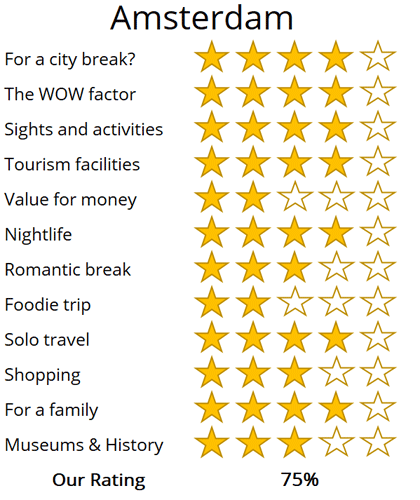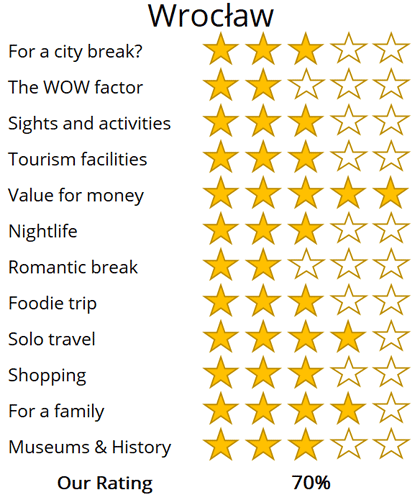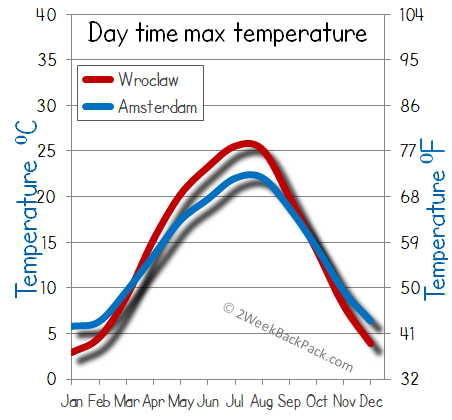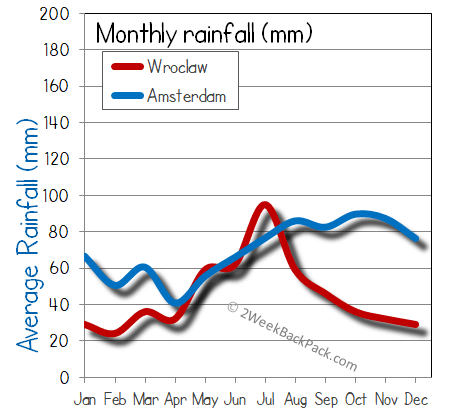WhereToGoForMyHoliday.com
The best destination comparison site!
WhereToGoForMyHoliday.com
The best destination comparison site!
Wroclaw or Amsterdam, which is better for your holiday in 2024?
Amsterdam and Wroclaw both offer unique and enticing experiences, but which one should you choose for your city break or holiday?
We recognise the difficulty in making this decision. While there is abundant information available on both destinations, clear guidance on which city better aligns with your travel preferences is often hard to find.
This article aims to provide an impartial comparison of Amsterdam and Wroclaw, and hopefully help you to choose the best city to visit.
The article is structured into several sections, each of which can be directly accessed through the following links:
• Introduction to the cities
• Scores and ratings
• Which one should I, friends, or family visit?
• When to visit and weather
• Who is the city suited for?
• The perfect 48hours (with map)
• Tourism details (where to stay? airport details?)
Introduction to Amsterdam and Wroclaw
Amsterdam, known as Europe's most liberal city, is an exceptional destination full of charm and unique character. While it continues to attract visitors drawn to its quirky and unconventional side, such as the famous coffee shops selling everything but coffee, and the infamous red-lit streets, the city is striving to transcend these stereotypes.
Today, Amsterdam is reinventing itself as a hub of culture and style, boasting world-class museums, a vibrant nightlife, and a welcoming attitude that distinguishes it from other cities. Far from a one-dimensional destination, Amsterdam offers an enriching experience that marries its lively past with an exciting and sophisticated future.

Wrocław has a beautiful preserved historic centre
Wroclaw is the historical capital of the Silesia region. It's been ruled and fought over and shaped by countless tribes and peoples, from the warring Slavs of the first millennium to the Habsburg emperors to the Prussian generals of the 1800s.
This makes it a strangely diverse and varied city, with Germanic townhouses and Flemish-styled mansions next to Gothic cathedrals and USSR tenements.
Wroclaw is a good-looking city. It's got a beautiful perch on the Oder River, spreading from island to island with arched bridges that recall Venice and wooded parks aplenty.
The Old Town is the anchor of it all, and a great place to wander, people watch, and drink Polish beers. Beyond come the fairy-tale spires of Cathedral Island, the colossal concrete dome of Centennial Hall (a UNESCO site), and even Zen parks inspired by Japan.

The historic centre of Wrocław and the Odra River
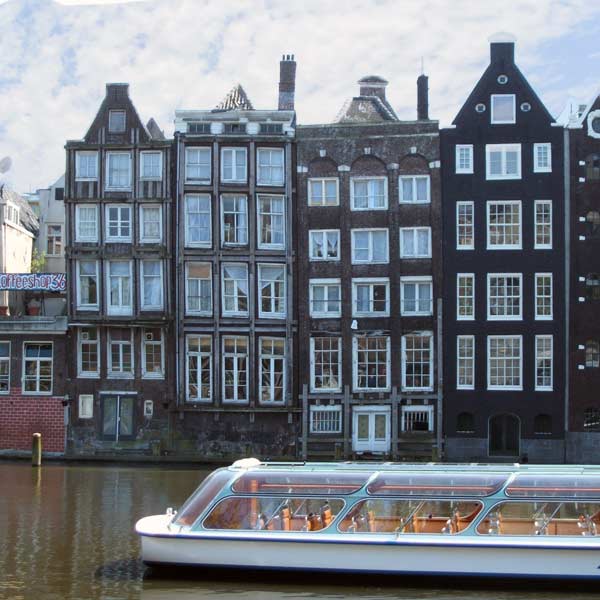
Singel canal in Amsterdam with typical Dutch houses and houseboats.
High-level summary Amsterdam and Wroclaw
Summary
Where would I journey for a personal escape? Amsterdam
Where would I send my parents for a memorable visit?
Amsterdam
Where's the ideal destination for my adventurous 19-year-old cousin?
Amsterdam
Where should my food-obsessed friend indulge their culinary passions?
Amsterdam
Note: The above comparisons are weather-independent and are based on travel during the most opportune times of the year. Details about the ideal travel seasons are elaborated upon later in this article.
In the sections that follow, you'll find a comprehensive comparison between these two fascinating cities. This includes recommendations on the duration of stay, the best times to visit, and tailored 48-hour itineraries for each city.
The final segment delves into practicalities for your travels, such as the best airport to fly into, the optimal districts for your accommodation, and insider tips, for when you come to explore the city.
We hope that you find all of this information useful, in planning your next exciting trip!
Destination details
How long to spend each city?
Wroclaw may not be vast in size, but it stands as one of Poland's prominent cities. Its Old Town, brimming with charm, is perfectly navigable on foot, while an efficient tram network offers a swift tour of the key attractions for a modest sum. Generally, a day or two suffices to experience the city’s highlights, making Wroclaw an ideal destination for a brief, fly-in, fly-out weekend retreat.
For those contemplating a more extended stay in Wroclaw, consider interspersing your visit with day trips to the surrounding areas. Nearby, you can explore the forested slopes of Karpacz, visit the awe-inspiring castles along the Eagles Nest Trail, or make a pilgrimage to the sacred site of Jasna Góra.
A three-day stay is perfect to truly capture the essence of Amsterdam, allowing for a brief day trip beyond the city limits. Any shorter visit might feel hurried, particularly for first-time visitors.
If time allows, the surrounding area boasts a wealth of worthwhile destinations. Keukenhof, the world's largest flower garden, is a popular destination in spring. Additionally, the Zaanse Schans Windmills and the enchanting 'Kasteel De Haar' castle are nearby
Additionally, many visitors opt to explore the planned cities of Almere or Lelystad, constructed on reclaimed land and just a 20-minute train journey from the central station These modern cities take pride in showcasing cutting-edge architectural design.

There are over 350 charming dwarf statues are scattered throughout Wroclaw’s historic centre. These characterful figures even have their own tourist map, along with s tory behind each one….
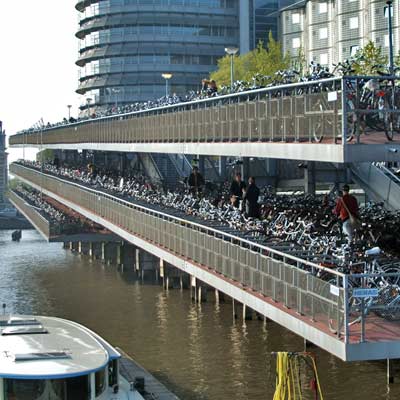
The Dutch love to cycle…..
Spring is the ideal time to visit Amsterdam, just before the rush of the summertime tourist season. During this period, you have the opportunity to partake in the festive King's Day celebration in April or marvel at the endless sea of tulips at Keukenhof.
August is Amsterdam's warmest month, with average temperatures hovering around 22 degrees Celsius (71°F) — a mild warmth by many standards! Winter can bring temperatures down to just above freezing, making for a chilly experience. The weather in Amsterdam is notoriously unpredictable throughout the year, so it's wise to come prepared for all conditions. Whether it's wind or rain, don't be surprised if at least one day of your visit is met with inclement weather.
Unless you're a fan of air pollution and sub-zero temperatures, Wroclaw is not the place to be in the winter. The whole of south Poland gets cold between November and March – really cold. We're talking minus 10 degrees regularly, with sudden snowfalls and freeing rain. Of course, when there is a dusting of the white stuff, the Old Town of Wroclaw can look wonderful, but recent winters haven't been so promising.
For sightseeing and enjoying the student buzz of the town, it's probably better to hold off until May. That's when the weather really starts getting good. You might have chilly evenings, but you should be able to don the shorts and t-shirts for your wanders through the city. What's more, the local university is in session, so the bars will be lively and vibrant.
Summer sees the students go home and the tourists arrive. It's a reliable period for weather, even if you have to deal with the occasional thunderstorm around early afternoon. September is just as nice, if not even better. That's when the trees of the island parks in Wroclaw start to change to yellow and ochre, lending a romantic atmosphere to the Silesian capital.
If you're the sort of traveller that loves to find off-the-beaten-track cities that don't necessarily have big-name sights, then Wroclaw is sure to be right up your alley. It's not as well known as other towns in Poland but comes with local vibes and interesting neighborhoods. It's also a student city, which means the nightlife can get pumping during term times (September to December and January to June).
Wroclaw has something for those who like the great outdoors, too. Not only is it a green place with lots of parks and riverside areas to explore, but the mountains of the Karpacz and the Czech borderlands are only a short drive to the south. They've got hiking, skiing, spa towns and more.
There’s something for everyone in Amsterdam.
While it has historically attracted hipsters, it also has a lot to offer to those looking for a peaceful and relaxed place to getaway. It’s easy to follow one of the canals out from Rembrandtplein in the centre to a quieter neighbourhood such as Jordaan or Prinsengracht either on foot or by bike, or even better, floating along by canal boat.
Believe it or not, Amsterdam is also an incredibly family-friendly city. The relaxed approach to parenting permeates its museums, sights and events and the city is home to hundreds of playgrounds and child-friendly cafes.
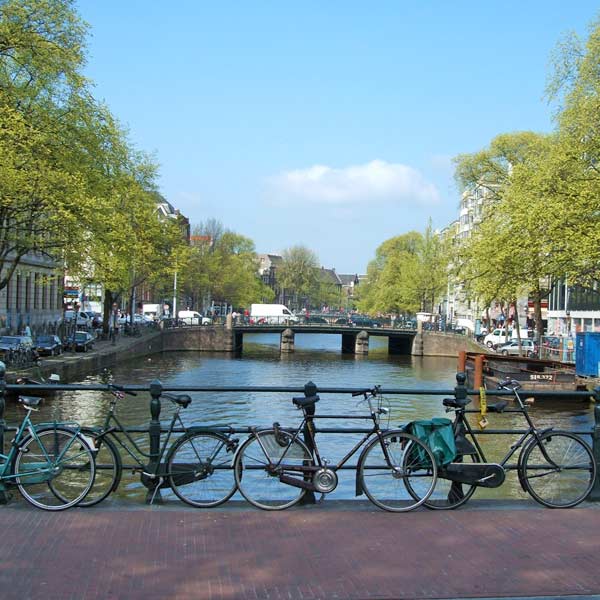
Amsterdam’s iconic canals, weaving through the city, create a picturesque and tranquil urban landscape

The twin spires of Wroclaw Cathedral
48hours in Wroclaw
Two days is all that's needed to explore Wroclaw from top to bottom. Most of your time will be spent in the charming Old Town area, but a few jaunts to parklands and other districts can combine with lively nights on the beer to boot…
The interactive map below shows a suggested route for the 48 hours in Wroclaw, with day 1 highlighted in green and day two in yellow.
Day 1: Every history lover, people watcher, foodie and sightseer will want to see the Stare Miasto district. That's the Wroclaw Old Town; the piece de resistance of this southern city. It begins around the wide boulevard of Piłsudskiego, passing through a few blocks of Soviet-era tenements before hitting the historic area proper. That starts in earnest by the Fosa Miejska, a centuries-old moat that was part of the town's medieval fortifications until it was destroyed by Jérôme Bonaparte, the brother of Napoleon.
On the left as you make for the heart of the quarter is the elegant Wrocław Opera House, while the leafy walks of Park Staromiejski are the perfect place to go for a picnic in the summer. Keep going north and you'll eventually arrive at the Rynek. This is the beating kernel of the Old Town, where you'll find the most amazing sights of all.
The Gothic-styled Old City Hall draws the eye first, followed by the German-built housing blocks of 1931 – considered by the locals to be among the ugliest in town! Be sure to check out the narrow alleys that weave through the middle of the square at the Sukiennice. Also keep the eyes peeled for the little dwarf statues that dot the plaza. They're a kitschy addition to the cityscape that you'll find on many random street corners.
As the afternoon turns into evening, consider settling in for a beer tasting at the hearty Spiż microbrewery. Or, head for Setka, where Communist paraphernalia adorns the walls and you can sample potent vodka with pickled herring.

The Most Tumski Bridge, where romantics leave love locks attached to the rails and throw the key in to the Odra River. To the rear is the spire of the Bartholomew’s church and the twin spires of the cathedral
Day 2: Having explored the Old Town, our second day begins with an exploration of the surrounding islands on the Oder River. There is a plethora to see, but the highlight is undoubtedly the iconic Ostrów Tumski.
Crossing the picturesque bridges to reach it, you will find yourself in the oldest part of Wroclaw.
The Wrocław Cathedral, with its towering twin spires, dominates the skyline, marking the most majestic church in the city. Inside, you can admire the exquisite stained-glass windows and the soaring vaulted apses.
From there, proceed to Słodowa Island, particularly delightful in the summer months when people gather by the riverside with their BBQ grills. Another worthwhile stop is Wyspa Piasek, renowned for its attractive chain bridges and quaint cobbled streets.
In the afternoon, take tram numbers 2, 4, or 10 from the Old Town to Centennial Hall, a magnificent UNESCO World Heritage Site celebrated for its revolutionary concrete architecture and a dome reminiscent of Rome's Parthenon.
Adjacent to it are beautiful gardens, with the serene Ogród Japoński as the highlight – an ideal spot for contemplation and reflection on Wroclaw's rich history.

The Centennial Hall may cause divisive opinions, but it was one of the first large reinforced concrete structures that ushered in the era of Modernism.
48hours in Amsterdam
Day 1: Start in the Museum Quarter, home to some of Amsterdam’s world-class museums. Here, you'll find the Rijksmuseum, housing Rembrandt’s famous 'The Night Watch,' as well as the Van Gogh Museum and Stedelijk Museum, which boasts an extensive collection of works from artists such as Picasso and Warhol.
In the afternoon, explore the charming artisan neighborhood of Jordaan, known for its houseboats along the quays and crooked historical buildings. For nightlife, the lively areas of Leidseplein or Rembrandtplein are perfect destinations.

Spring at Dam Square with the Royal Palace in the background.
Day 2: Begin with a visit to Dam Square and the Royal Palace, then venture into the red-light district. A trip to the Anne Frank House offers a poignant experience; booking online ahead of time is highly recommended..
For a more relaxed evening, capture a beautiful photo from the Magere Brug. After dark, this bridge, adorned with over a thousand lights, provides a vantage point from which you can see 15 bridges simultaneously.
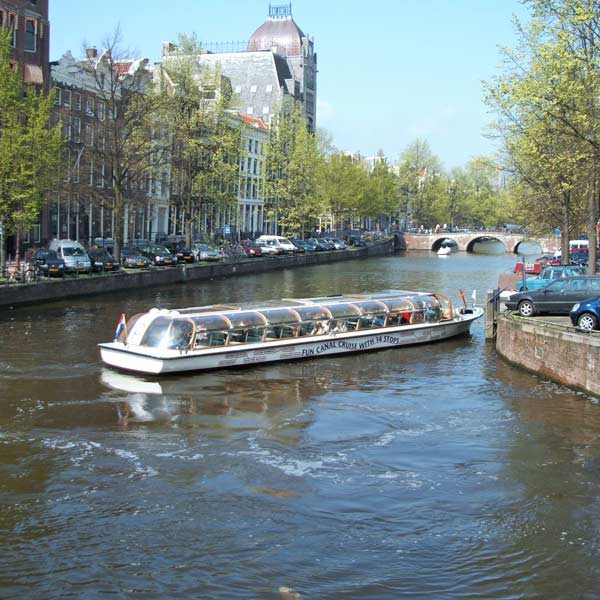
Boat cruise along a canal in Amsterdam
On arrival in Amsterdam Schiphol airport, the quickest way to get into town by public transport is the train which costs €5.40 and takes 20 minutes. The bus costs €5 and takes about 35 minutes.
Amsterdam is an expensive city. Walking and cycling are the best ways to get around. By boat you can see all the big sights too and there are many options for hop-on-hop-off. There is also an impressive public transport system of trams, buses, metros, trains and ferries to help you get around.

Rijksmuseum in Amsterdam
All cities have their perils but with regards to Amsterdam, probably the main ones to consider are bike safety and caution in the "coffee shops". As well as the usual bike safety rules you’d expect at home, keep an eye out for nippy scooters on the bike lanes and avoid rush hour if possible. In terms of the coffeeshop visits – don’t underestimate the effects of the products, as the varieties sold here are more potent than elsewhere.
Amsterdam is typically an extremely safe city for solo female travellers but it’s not advised to visit the Red Light District at night as the area does have a seedier vibe.
The ever-expanding Wrocław–Copernicus Airport is now served by loads of routes coming from across Poland and Europe. It's even possible to arrive on long-haul connecting flights thanks to Poland's flag-carrying LOT airline. There's a bus that leaves the terminals for the centre of town every 20 minutes throughout the day. Tickets cost 3 PLN and the ride is around half an hour.
You can also arrive from Krakow, Warsaw or Katowice by rail. Wroclaw's train station is considered a work of art in itself, so be sure to check out the yellow-painted façade and its grand crenulations as you leave.
Getting around Wroclaw should be easy. The town centre isn't only walkable but a real pleasure to explore on foot. There are lovely bridges linking the little isles on the Oder River, parks connecting the banks of the old city fortifications, and plenty of pedestrianised areas within the confines of the Old Town.

Many of Wrocław oldest builds, were constructed use red bricks
To get out to the Centennial Hall, Wroclaw Zoo, or other districts, you can make use of the efficient tram network. Buy tickets at the MPK Wroclaw machines at any bus or tram stop and then validate them as you board. Basic fares cost 3 PLN per ride, but you can also score passes for several days using the Urbancard website.
Hotels in Wroclaw are generally all located within the ring road of Piłsudskiego. Roughly speaking, the closer you get to the Rynek square the better the location, though staying right on the main plaza might be noisy at night. There are also some lovely boutique stays and B&Bs to find north of the Oder River.
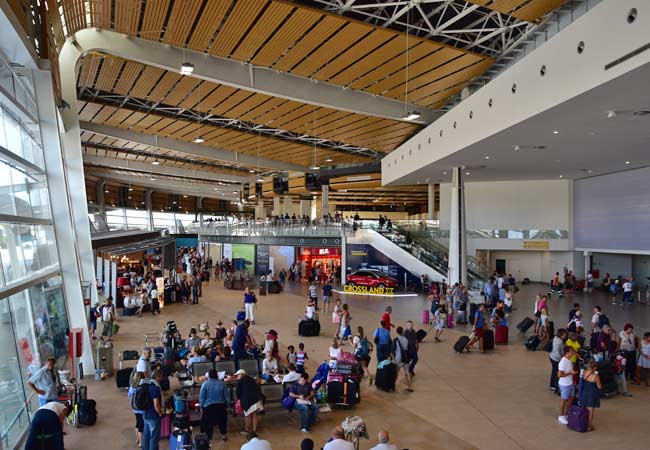
oh we were stuck in the airport!

Copenhagen was a bit expensive...

All we did was drink beer in Brussels...
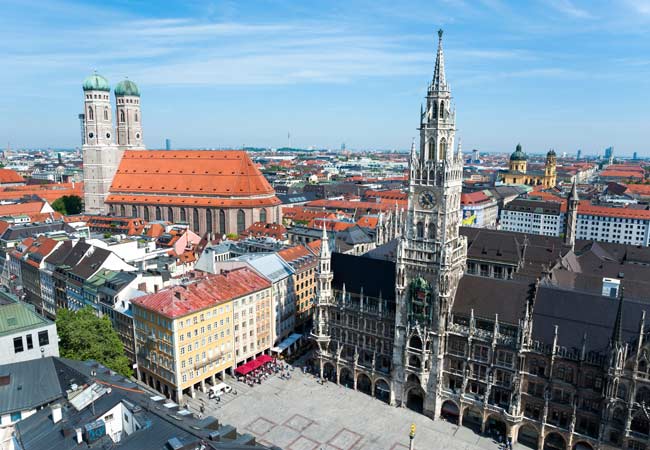
Muncih was crazy
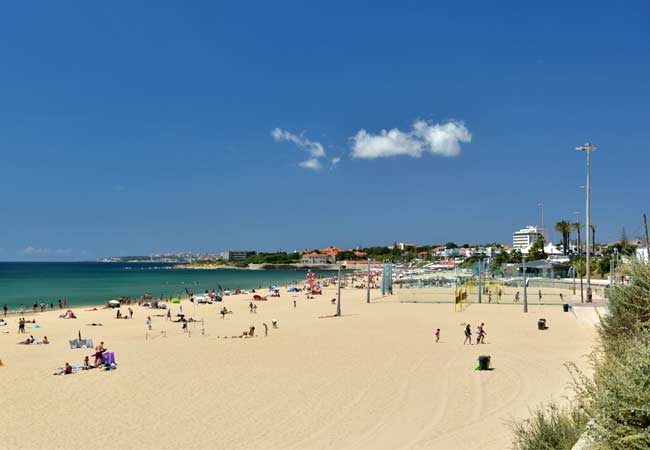
And we got so burnt!
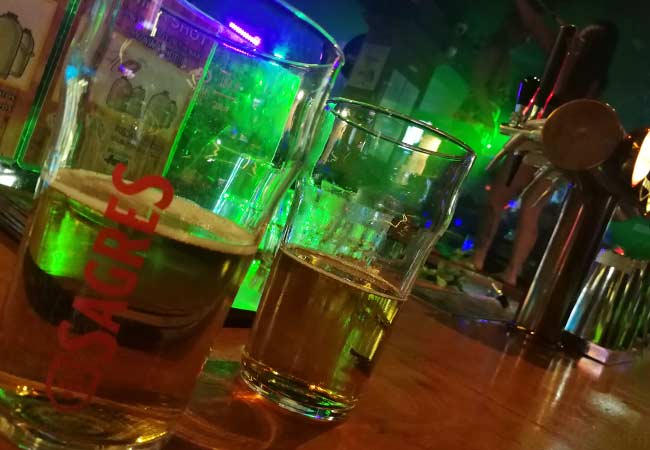
Remeber that night in Rome

oh we were stuck in the airport
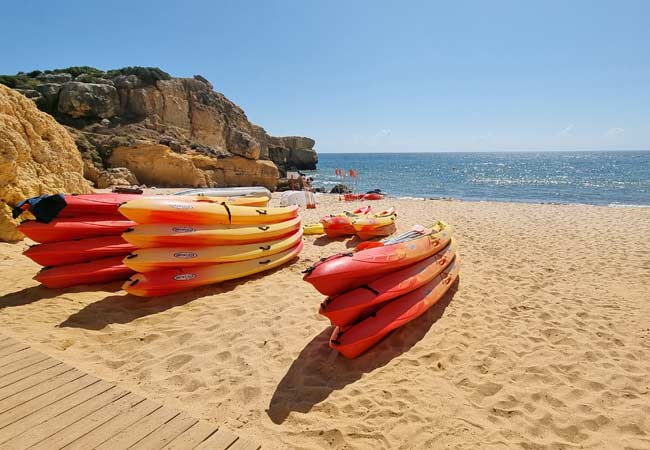
So much fun kayaking

Berlin and that group from Austria!

There was such a view from that church

And we got so burnt!

Munich was eventful, wasn't it!

Such a view from that cathedral in Florence
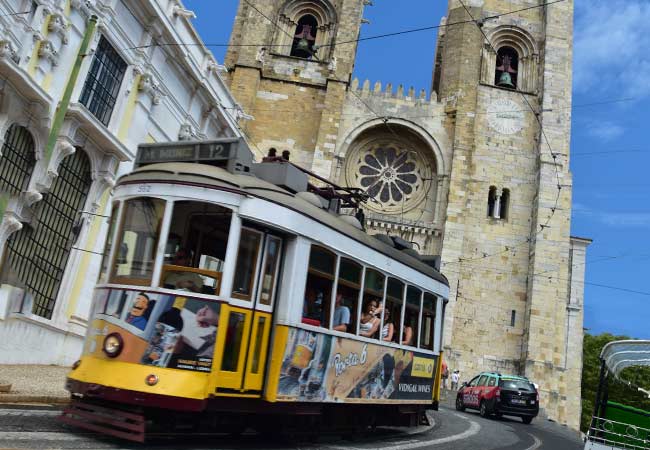
Lisbon was such so much fun

Last summer was so much fun .... x

Remeber that night in Rome

Lisbon was such so much fun

Such a view from that cathedral in Florence

Munich was eventful, wasn't it!

And we got so burnt!

Remeber that night in Rome

All we did was drink beer in Brussels...

Berlin and that group from Austria!

Can't wait to go back to Dubrovnik

Remember that boat ride in Prague

Copenhagen was a bit expensive...
